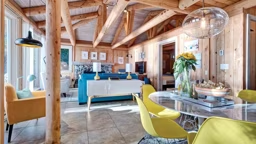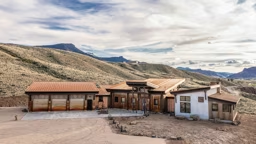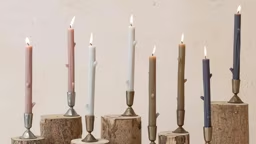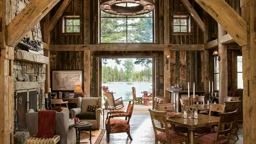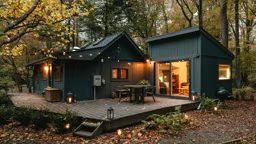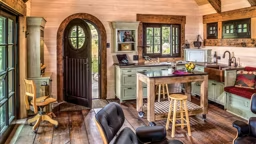Stairs With Rustic Style
Spiral stairs aren’t for everyone. But straight doesn’t have to mean straight-laced. With tree trunks that seem to be growing out of the floor for newel posts, twigs for balusters and branches for railings, a rustic staircase is anything but.
“Rustic stairs can bring a cabin to life,” says architect Christopher Williams of Meredith, N.H., whose designs often incorporate root flares along with twig balusters that curve into half-log treads. What’s important, stresses Williams, is creating a tight fit. Scribing all parts to follow the irregularities of the materials ensures that the stairway won’t wobble. Also, since logs will settle, it’s critical to design joinery so it will accommodate the movement.
Before you purchase log stairs, check with your building inspector, advises Gary Fuller of Jim Barna Log Systems. Open risers are a problem in some townships, notes Fuller. And remember, rustic stairs with full log or heavy timber stringers are bigger than the average stair and may not fit through a standard door opening. “I had one set of stairs that weighed about 1,800 pounds and was in one piece,” recalls Fuller. “It took 12 men to install it in a finished home.”
A good professional stair builder can make your flight of fancy a reality. If you can’t locate one in your area, there are a number of companies on the Internet that will design a stairway to your dimensions and ship it complete or in kit form. Some firms charge more for add-ons such as landing decks for spirals; make sure that the price you’re quoted includes everything you’ll need.
Don’t want to replace an existing staircase? Rustic-customize, suggests craftsman Daniel Mack. By changing stairway components, you can create your own version of a woodsy Adirondack camp or Ozarks hunting lodge. Mack’s installations typically feature applewood newel posts and railings, with maple fork balusters. But before you rush out and chop down that gnarled apple tree behind the cabin, remember that wood needs to dry for a year or two.
Do Tread on Me
Of course you’ll want to keep safety and practicality uppermost.
Most importantly, stair treads and landings should be well-lighted.
Are tots or pets frequent users? Space balusters close enough so wee ones can’t fall through or get stuck.
A good rule of thumb from the Hardwood Manufacturers Association: If a 6-inch ball can pass between them, balusters are too far apart.
Will anyone be toting laundry or bulky sports gear up or down regularly? A straight stairway is easier to navigate than a spiral.
Building code requirements, properly followed, help prevent accidents. Here’s a summary of the 2000 International Residential Code regulating stairways with two or more risers:
• Straight stairways should have a minimum width of 36 inches.
• On straight stairways, the maximum riser height should be 7 inches; the minimum tread depth should be 10 inches.
• All treads should have the same dimensions; so should all risers.
• Open risers should have a maximum 4-inch opening.
• Main stairways should have minimum headroom of 6 feet 8 inches. Seven feet or more is desirable to allow for moving furniture.
• Handrails should be provided on at least one side of stairway and be continuous the full length of the stairs.
• Spiral stairways should have a minimum width of 26 inches, with each tread having a 7-inch minimum tread width at 12 inches from the narrow edge.
• Circular stairways should have a tread depth of not less than 11 inches; the minimum depth of any tread should be no less than 6 inches.
Source: Stairway Manufacturers Association www.stairways.org
Making the Most of Space
Space under the stairway is ideal for storage. Here are some ideas.
1. Take a cue from the photo at left and build in open shelves or cubbies for books, photographs and collectibles.
2. Build in cupboards to stash the vacuum cleaner or other items you want handy but out of sight.
3. Use a triangle of fitted cupboards for an adjoining kitchen.
4. Stack firewood for an adjacent hearth.
5. Tuck a rolltop or a fly-fishing desk under half-log stair risers.
6. Nestle a small rustic table and chair under a curved stairway.
7. Use Adirondack pack baskets for storing gloves or walking sticks.
8. Create a half-bath under the stairs.
Stairways are more than just a means of getting from the great room to the sleeping loft.
Stairs can heighten drama and add architectural interest to your cabin. Well-designed stairways create additional storage or functional niches. In an open floor plan, they help define activity areas.
Stairways also provide the perfect backdrop for quilts, family photos or cabin collectibles. And during the holidays, what’s more festive than a stairway swagged in balsam and twinkling lights?
Whether you’re remodeling, planning an addition or building your dream cabin from the ground up, address the stairway. With the right setting, lighting and “wardrobe,” you can turn an understudy into a leading lady.
The first consideration is location. Do you want the stairway to take center stage, wowing guests when they arrive? Or is it better cast in a supporting role, running up a perimeter wall? As for design, the sky’s the limit: straight or curving, continuous run or landings, open (without walls on one or both sides) or closed.
Step by Step
Essentially, a stairway is a succession of horizontal treads with some means of support. Most often, that’s diagonal stringers.
Usually there are risers (the vertical back of each step), but open risers or gaps between treads give a sense of space, open a view beyond or showcase a great room, fireplace or other dramatic feature.
Balusters support the railing.
Newel posts at the bottom and top of a stairway are the major support posts.
Straight stairs are ideal for airy, spacious cabins. They’re also the simplest, the least expensive and the best for accessing frequently used areas.
If space allows, you might want to break up a straight run – or change direction – with a landing. L-stairs have a landing that changes the direction at a 90-degree angle. U-stairs run parallel to each other at different planes connected by a landing.
Where there’s a skylight or a landing with a window, a straight stairway will draw light down through the cabin. Shoehorn a bookcase and an easy chair onto a landing to create a reading nook. If your aerie has a view of the lake or mountains, so much the better.
Curved staircases attach at one wall and wind upstairs. Either straight or curved open stairs enhance a large great room.
Spiral stairs are the most compact. They work well in cabins with a small footprint, freeing up otherwise wasted space. And spirals are gaining in popularity, according to Anna Garber, marketing director for Precision Pine Inc., a stair manufacturer at the foot of the Great Smokies in Tennessee. Precision Pine started selling spirals locally to rental cabins nine years ago; today, it sells southern yellow pine and oak spirals all over the country. “People with second homes like something a little different when on vacation,” says Garber. “Spirals save space and look great.”
Spirals also offer a wealth of space-saving solutions. When brothers Matt and Jon Wile purchased a lakeside second home in the Adirondacks, for example, a staircase led from one corner of the family room upstairs to three bedrooms. After consulting with an architect, the Wiles replaced it with a central spiral staircase. Reconfiguring the landing created enough space for a fourth bedroom so that both Wile families can vacation together.
Stair builder Steven Errington of Premium Wood Works suggests extending spiral stair treads out for shelving, plant holders – even seating.
Essentially, a stairway is a succession of horizontal treads with some means of support. Most often, that’s diagonal stringers.
Usually there are risers (the vertical back of each step), but open risers or gaps between treads give a sense of space, open a view beyond or showcase a great room, fireplace or other dramatic feature.
Balusters support the railing.
Newel posts at the bottom and top of a stairway are the major support posts.
Straight stairs are ideal for airy, spacious cabins. They’re also the simplest, the least expensive and the best for accessing frequently used areas.
If space allows, you might want to break up a straight run – or change direction – with a landing. L-stairs have a landing that changes the direction at a 90-degree angle. U-stairs run parallel to each other at different planes connected by a landing.
Where there’s a skylight or a landing with a window, a straight stairway will draw light down through the cabin. Shoehorn a bookcase and an easy chair onto a landing to create a reading nook. If your aerie has a view of the lake or mountains, so much the better.
Curved staircases attach at one wall and wind upstairs. Either straight or curved open stairs enhance a large great room.
Spiral stairs are the most compact. They work well in cabins with a small footprint, freeing up otherwise wasted space. And spirals are gaining in popularity, according to Anna Garber, marketing director for Precision Pine Inc., a stair manufacturer at the foot of the Great Smokies in Tennessee. Precision Pine started selling spirals locally to rental cabins nine years ago; today, it sells southern yellow pine and oak spirals all over the country. “People with second homes like something a little different when on vacation,” says Garber. “Spirals save space and look great.”
Spirals also offer a wealth of space-saving solutions. When brothers Matt and Jon Wile purchased a lakeside second home in the Adirondacks, for example, a staircase led from one corner of the family room upstairs to three bedrooms. After consulting with an architect, the Wiles replaced it with a central spiral staircase. Reconfiguring the landing created enough space for a fourth bedroom so that both Wile families can vacation together.
Stair builder Steven Errington of Premium Wood Works suggests extending spiral stair treads out for shelving, plant holders – even seating.
Wood, Metal or Glass
Stairways can be made from hardwoods and exotic woods, iron, steel, aluminum, brass, bronze – even glass.
There’s no rule saying you can’t vary the species of woods used for stairway components – or even for each stair tread. In fact, different-colored treads are easier to distinguish. Another option is to use complementary woods for stairs and floors, with an inlay of the stair wood to accent flooring. Inlays also are a possibility for risers.
Wood and metal together make stunning staircases. Metal works well for railings, balusters and balcony panels. Unlike wood, it can be thin and strong, thus allowing more light to pass through to stairs and upper floor balcony areas.
If you’re considering metal, try to visit the showroom of a metal artisan as well as a large-scale retailer. Decide whether you like the look and texture of hand-forged metalwork or of a stamped-out design.
Metal doesn’t have to be black and glossy, states Rhoda Mack of Fine Architectural Metalsmiths in Chester, N.Y. Iron can be waxed or oiled to look like aged or polished bronze, nickel silver or pewter. Metal also can be coated in a series of transparent dyes that change the appearance from bronze to browns and blacks with the colors of the ambient light.
Metal panels for wood stairs and balconies are extremely popular, according to Jerry Bement of J.Dubs in Ellensburg, Wash. J.Dubs’ panels are made of 10-gauge, 3/16-inch thick plate steel. Powder coating color options range from black to copper, green and white.
The stairway should reflect the spirit of your cabin, whether rustic or contemporary. In a Southwestern vacation home, terracotta tile treads between half-walls of adobe-like plaster beckon you upstairs. Half-log treads offer sure footing in a log cabin.
Spare, clean lines, on the other hand, suit a beach house. For an “ocean glass” effect, consider architectural-cast glass treads, perhaps with a teak or steel railing. Staircases can be rigged like yachts with halyards, turnbuckles and cables; a rope handrail embellishes a maritime theme.
Whatever materials you choose, they should be durable. Stairways are one of the most used parts of the cabin and, as with any star, you’ll want them to age gracefully.
Frances Sigurdsson enjoys the ups and downs of lakeside living in the Adirondacks.








